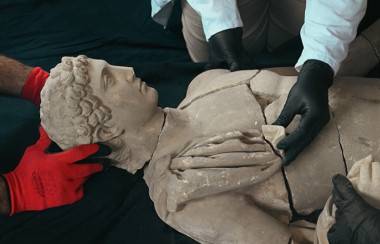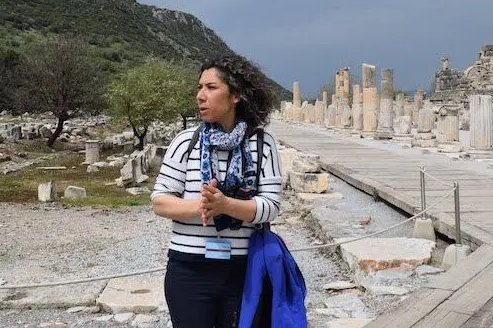Monumental Hermes Statue Discovered in Aspendos Ancient City
Excavations in the ruins of a monumental fountain, located east of Theater Street, have revealed several remarkable artifacts, including the heads of Aphrodite and Eros, as well as statue fragments of Artemis and Nemesis.
The most significant find among these discoveries is a statue depicting Hermes, the swiftest of the gods and the messenger of Olympus. The statue portrays Hermes holding a money pouch in his right hand, while his left hand grasps his cloak draped over his shoulder and his signature caduceus (kerykeion) staff. At his left foot, a ram figure gazes up at Hermes, adding a symbolic touch to the sculpture.
The way Hermes is positioned on the pedestal demonstrates the artist’s effort to achieve a harmonious balance of motion and stability in the figure’s posture.
(Related: Two-Meter Aphrodite Statue Discovered in Perge Ancient City)
Restoration and Dating of the Hermes Statue
The statue, discovered in multiple fragments, was carefully restored in the excavation house to reconstruct its original form. Including its base, the entire piece stands at a height of 1.65 meters. Stylistic analysis suggests that it dates back to the late 2nd to early 3rd century AD, placing it within the Roman Imperial period.
Hermes: Guardian of Travelers and Merchants
In Greek mythology, Hermes is recognized as the god of roads, commerce, hospitality, and diplomacy. He was also regarded as the protector of merchants, herds, and shepherds. Beyond these roles, Hermes functioned as a divine messenger, facilitating communication between the gods, and guiding the souls of the deceased to the underworld, Hades.
Often depicted as a youthful, athletic figure, Hermes was also associated with dreams, as he was believed to be the recipient of the final drink offerings before sleep. His most recognizable symbol, the caduceus (kerykeion), is a staff entwined with two serpents and adorned with wings, representing his swiftness and authority.
Ancient depictions of Hermes varied widely; sometimes he was portrayed as a mature, bearded figure wearing a long tunic, while in other representations, particularly during the Roman period, he appeared as a youthful, agile deity. The newly discovered Hermes statue in Aspendos reflects this diversity in artistic interpretations.
Ongoing Excavations at Aspendos
Archaeological excavations in Aspendos Ancient City continue to shed light on the region’s historical and cultural heritage. As part of the "Heritage for the Future" project, researchers have not only uncovered the Hermes statue but also identified various statue fragments believed to represent Aphrodite, Eros, Artemis, and Nemesis.
This discovery underscores Aspendos’ significance not only as an architectural marvel but also as a center of art and mythology that provides valuable insights into the social and religious structures of the time. Archaeologists anticipate that these findings will contribute to a deeper understanding of daily life and belief systems in the ancient world.
The excavation efforts in Aspendos highlight the importance of preserving and studying ancient civilizations, ensuring that their cultural and artistic contributions continue to inspire future generations.
Related Tours
Shore Excursions, Private Tours & Transfers for Guests .
House of Virgin Mary, Ancient City of Ephesus, Basilica of St.John
-
Shore Excursions
-
Private
Ephesus played an important role in the spread of Christianity. Ephesus is&...
Discover Majestic Ephesus
-
Shore Excursions
-
Private
Majestic Ephesus takes you on an unforgettable journey through history; etched on minds as the...
Ancient City Of Ephesus, House Of Virgin Mary, Basilica Of St. Jhon
-
Shore Excursions
-
Private
Ephesus played an important role in the spread of Christianity. Ephesus is&...
Ancient Ephesus & Turkish Bath (Hamam)
-
Shore Excursions
-
Cruise
Ephesus; the most important commercial and trade center of the ancient world.
Ultimate Ephesus
-
Shore Excursions
-
Private
Terrace Houses: Admire the frescoed walls, mosaic flooring and peristyle courtyards of homes where E...











